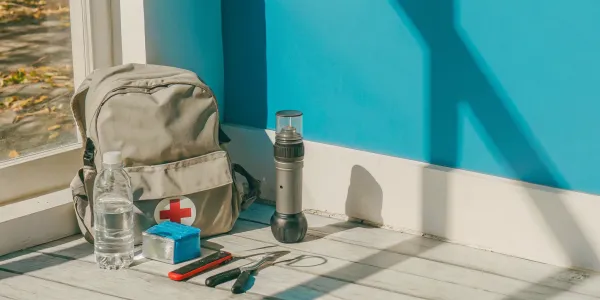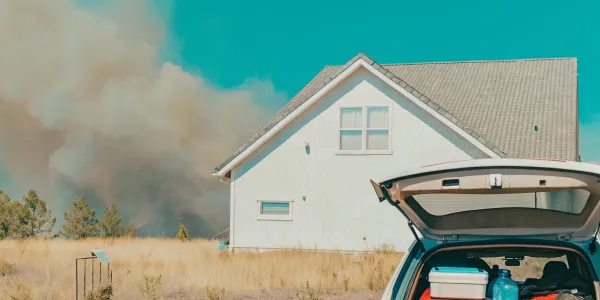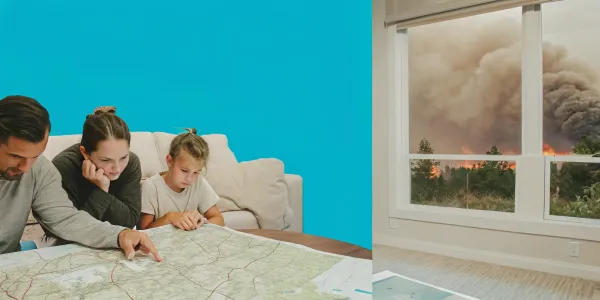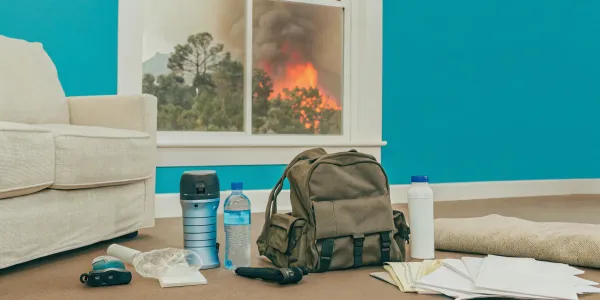Class A Roofing: Wildfire Protection for Your Home
Class A roofing offers top wildfire protection for your home. Learn about materials, insurance benefits, and how to choose the right fire-rated roof.
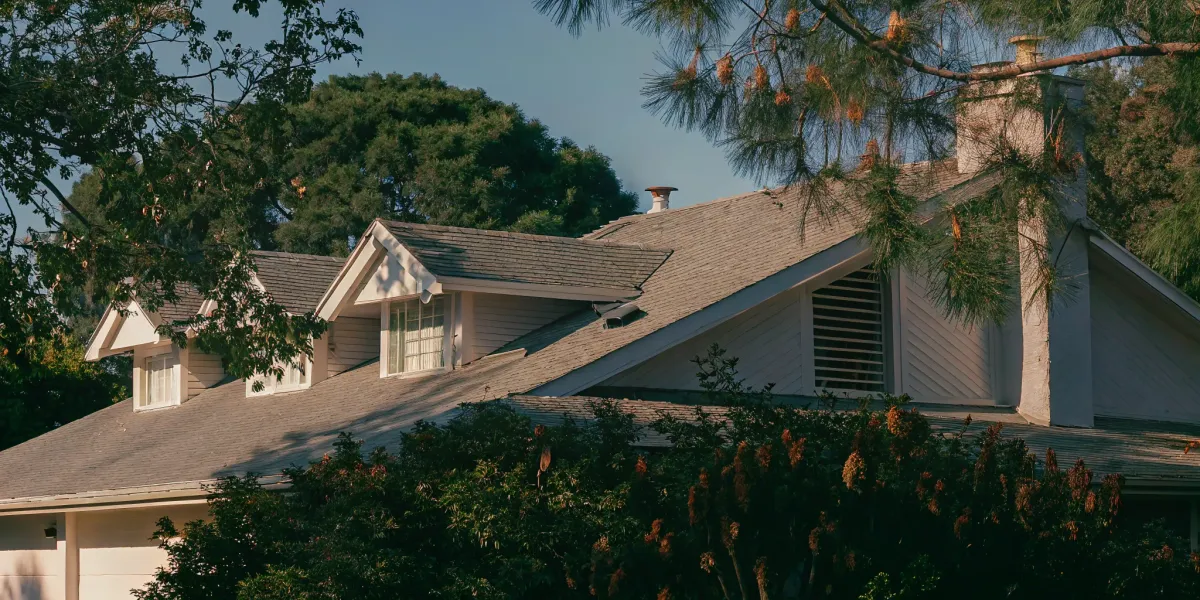
During a wildfire, the biggest threat to your home isn’t always the wall of flames you see on the news. It’s the storm of tiny, glowing embers that can travel a mile or more ahead of the fire, landing on rooftops and igniting homes far from the main blaze. Your roof is your home’s primary shield against this danger. An old, unrated wood shake roof can catch fire in minutes, but a modern, fire-resistant roof can mean the difference between a close call and a total loss. That’s where class a roofing comes in. It offers the highest level of fire resistance available, specifically tested to withstand severe ember attacks. This guide explains your options and why this upgrade is the cornerstone of any effective home hardening plan.
Key Takeaways
- Prioritize a Class A Roof for True Ember Defense: This is your home's most critical shield. The Class A rating applies to the entire roofing system—not just the shingles—and is specifically tested to resist ignition from wind-blown embers, the number one cause of home loss in a wildfire.
- Installation and Code Compliance Determine Effectiveness: A fire-resistant roof only works if it's installed correctly. You must hire a qualified professional who follows local building codes to ensure your roof performs as intended, validates its warranty, and passes inspection.
- Leverage Your Upgrade for Insurance Security: Proactively communicate with your insurer before and after installing a Class A roof. Keep all documentation, including permits and receipts, to prove you’ve reduced your home's risk, which can be critical for maintaining coverage or qualifying for discounts.
What is a Class A Fire-Rated Roof?
When you live in a wildfire-prone area, your roof is your home’s first line of defense against airborne embers, which can travel a mile or more ahead of a fire. A Class A fire-rated roof offers the highest level of protection available, designed to withstand severe fire exposure without catching fire or allowing flames to spread. This rating isn’t just about the shingles or tiles; it applies to the entire roofing system, from the underlying materials to the surface covering.
Think of it as a complete, tested assembly built to keep your home safe. For homeowners looking to reduce their wildfire risk and maintain insurance coverage, installing a Class A roof is one of the most effective steps you can take. It’s a foundational part of home hardening that insurers and fire officials prioritize, and a critical component of a solid Wildfire Action Plan.
What Do the Fire Ratings (A, B, C) Actually Mean?
You’ll often see roofing materials described with a letter grade: A, B, or C. These roof fire ratings are a straightforward way to understand how well a roof can resist an external fire. Class A is the top tier, offering the highest resistance to severe fire. Class B provides protection against moderate fire exposure, and Class C withstands only light fire exposure.
For anyone living with wildfire risk, Class A is the only rating that truly matters. It signifies that the roofing material has passed the most stringent tests and won’t contribute to the spread of a fire. Some older materials, like untreated wood shakes, are often "unrated," meaning they fail to meet even the minimum (Class C) requirements and can pose a significant hazard.
How a Roof Earns Its Class A Rating
A Class A rating isn’t just a label a manufacturer can assign to its products. To earn it, a roofing system must undergo rigorous, standardized testing by an approved testing agency like Underwriters Laboratories (UL). These tests, such as the UL 790 or ASTM E108, simulate severe fire conditions. They measure how the roof handles direct flame, intense heat, and the ability of embers to burn through the material and ignite the underlying roof deck.
The entire assembly is evaluated to ensure it works together to prevent fire from penetrating your home. This certification process gives you confidence that your roof meets proven performance standards and will function as expected when you need it most.
Myths vs. Facts: What "Fire-Resistant" Really Means
The term "fire-resistant" can be confusing, so it’s important to separate fact from fiction. First, no roofing material is completely "fireproof." A Class A rating means the material is highly effective at resisting ignition and flame spread, not that it’s indestructible. It’s designed to buy critical time and prevent embers from starting a new fire on your roof.
Another common myth is that heavy materials like slate or clay are automatically the safest choice. While they offer excellent fire resistance, their extreme weight can become a hazard for firefighters if the home’s structure is compromised in a fire. Modern composites and metal roofing can provide the same Class A protection at a fraction of the weight.
What Are My Class A Roofing Options?
Choosing a Class A roof doesn't mean you're stuck with one look or material. You have more options than ever before, from traditional materials known for their durability to modern composites that offer a specific aesthetic without the risk. Understanding these choices helps you find the right balance of protection, cost, and style for your home. Your roof is your first line of defense against embers, so picking the right material is one of the most important home hardening decisions you can make.
The key is to find a material that meets strict fire-resistance standards while also fitting your budget and local building codes. Let's walk through the most common categories so you can feel confident when speaking with contractors and your insurance agent.
Classic Choices: Metal, Slate, and Clay Tile
When you think of a fire-resistant roof, these materials are often the first that come to mind. For good reason—they are inherently non-combustible. Class A materials include options like clay or concrete tiles, slate, and metal panels. These materials have a proven track record of withstanding extreme heat and preventing embers from igniting the structure underneath.
Metal roofs, available in standing-seam panels or shingles, are lightweight, durable, and excellent at reflecting heat. Slate and tile offer a timeless look and exceptional longevity, often lasting 50 years or more. However, they are also very heavy. It's critical to ensure your home's structure can support the weight, and it's a factor firefighters consider, as a heavy roof collapse poses a significant danger during a fire.
Modern Materials: Asphalt Shingles and Synthetics
You don't need a six-figure budget to get a Class A roof. Many modern asphalt shingle products are specifically designed and tested to meet Class A fire resistance requirements. These shingles are made with a fiberglass base mat, which is non-combustible, and coated with asphalt and protective mineral granules. They offer a great balance of affordability, performance, and ease of installation.
When shopping for asphalt shingles, you must confirm the product has a Class A rating. Don't assume all shingles are the same. The packaging and manufacturer's specifications will clearly state the fire rating. This is one of the most popular materials used for Class A roofs because it provides reliable protection without the high cost or structural demands of heavier materials like slate or tile.
High-Performance Composites
If you love the look of natural wood shakes but know they are a serious fire hazard, high-performance composites are the solution. These synthetic roofing products are engineered to mimic the appearance of materials like wood or slate while providing top-tier fire protection. For example, some companies make synthetic roofing that looks nearly identical to hand-split wood shakes but carries a Class A fire rating.
These composite materials are lightweight, durable, and often made from recycled materials, offering a sustainable choice. They solve a common dilemma for homeowners who want to maintain a specific architectural style without compromising safety. While the upfront cost can be higher than asphalt shingles, they provide a long-lasting, low-maintenance alternative that delivers both beauty and peace of mind.
Comparing Cost and Lifespan
Your budget will naturally play a major role in your decision. It’s helpful to think about roofing as a long-term investment. Asphalt shingles typically have the lowest upfront cost but may need replacement sooner than other options. Metal roofing costs more initially but can last for 50 years or more with minimal maintenance. Slate and tile are premium options with the highest price tag but can last a century.
Beyond the price, consider the total value. A longer-lasting roof means you won't have to worry about replacement costs for decades. It's also important to factor in installation, as heavier materials like slate require specialized labor and potentially reinforcing your home's structure. Weighing these factors will help you choose a roof that not only protects your home but also makes financial sense for the long haul.
Why a Class A Roof Is a Smart Investment
Thinking about a new roof can feel overwhelming, but it’s one of the most powerful moves you can make to protect your home and your finances. A Class A roof isn't just a line item on a renovation budget; it's a strategic investment in your family's safety, your home's insurability, and your peace of mind. When you weigh the costs, it’s important to look beyond the initial price tag and consider the long-term benefits. From withstanding a storm of embers to making your home more attractive to insurers and future buyers, a high-quality, fire-resistant roof pays for itself in more ways than one.
The Best Defense Against Embers
During a wildfire, the greatest threat to your home often comes from the sky. Wind-blown embers can travel a mile or more, landing on vulnerable surfaces. Your roof is the single largest, most exposed part of your house, making it the first line of defense. A Class A fire rating means the roofing material has passed severe fire exposure tests and won't easily ignite from these embers. According to the University of California's fire network, this is critical because embers are a primary cause of home ignition. Choosing a Class A roof is the most effective step you can take to prevent a stray ember from turning into a catastrophe.
Qualify for Insurance Discounts
As insurance becomes harder to find and afford, every proactive step you take matters. Installing a Class A roof is a clear, tangible signal to insurers that you are serious about reducing your property’s wildfire risk. While discounts aren't guaranteed everywhere, many carriers are beginning to offer premium reductions for homes with proven fire-resistant features. More importantly, having a Class A roof can be the deciding factor in whether you can get or keep coverage at all. It demonstrates you’ve made a significant investment in mitigation, making your home a more acceptable risk and potentially helping you access lower premiums.
Add Lasting Value to Your Home
A new roof is always a major home improvement, but a Class A roof adds a unique layer of long-term value. These materials, from metal to high-quality composites, are built for durability and require less maintenance over their lifespan, saving you money over time. This upgrade isn't just about safety; it's a smart financial move that can increase your property's overall worth. When it comes time for an appraisal, a resilient, code-compliant roof is a significant asset. It’s an investment that protects your home from physical damage while also strengthening its financial foundation.
Improve Your Home's Resale Potential
If you ever decide to sell, a Class A roof can be a powerful advantage, especially in a wildfire-prone area. Potential buyers are more aware of wildfire risk than ever before, and a fire-resistant roof provides immediate peace of mind. It tells them the home is resilient and has been thoughtfully maintained. This feature can make your property stand out and may even help it sell faster. For a new buyer, knowing the home is easier to insure removes a major hurdle in the purchasing process. It’s a premium feature that signals quality and safety, making your home a more attractive and responsible choice on the market.
Meet Local Building and Fire Codes
Choosing a new roof isn't just a matter of style or budget; it's a critical decision guided by local safety regulations. In areas threatened by wildfire, building and fire codes are your first line of defense. These rules aren't arbitrary. They are based on years of research into how homes ignite during a wildfire and are designed to protect you, your property, and your entire neighborhood. Following these codes is non-negotiable for ensuring your home is legally compliant and as safe as possible.
Meeting these requirements is also essential for your financial well-being. A code-compliant Class A roof can be a key factor in maintaining your homeowners insurance. Insurers look for proof that you’ve taken concrete steps to lower your risk, and adhering to local mandates is a powerful signal. Before you start calling contractors or picking out materials, your first step should be to understand the specific rules that apply to your property. This knowledge empowers you to make informed decisions, pass inspections, and secure the insurance discounts you deserve. Your local building department is the ultimate authority on these requirements, and a quick call or visit to their website can provide the clarity you need to move forward with confidence.
Know Your State and Local Requirements
Building codes can vary significantly from one state to another, and even between neighboring counties or cities. What’s required in a dense suburban area might be different from the rules in a rural community. For example, some building codes mandate Class A roofs only in specific high-risk locations or for certain types of buildings. You can’t assume a standard solution will work everywhere.
It’s your responsibility as a homeowner to learn the specific regulations for your address. The best place to start is with your local building department. They can provide the exact fire safety and building code information you need to follow for any roofing project. Getting this right from the start saves you from costly mistakes, failed inspections, and the potential denial of an insurance claim down the road.
What Are WUI Codes and Do They Apply to You?
If you live in an area where your home borders or is mixed in with natural vegetation, you are likely in what’s called the Wildland-Urban Interface, or WUI. Because these homes are at a much higher risk, they are often subject to stricter building standards known as WUI codes. These codes are designed to prevent homes from igniting due to windblown embers, which can travel a mile or more ahead of a wildfire and are a primary cause of home destruction.
WUI codes typically require Class A roofing, along with other home hardening measures like non-combustible siding and ember-resistant vents. To find out if your home is in a designated WUI zone, check with your local fire department or planning office. Understanding your WUI status is essential for creating an effective wildfire defense plan.
Pass Inspections and Keep the Right Paperwork
Installing a Class A roof is a major step, but the job isn’t finished until it passes a final inspection from your local building authority. This inspection verifies that the materials used and the installation methods meet all required codes. A professional, licensed contractor will handle the permitting and inspection process for you, but it’s smart to understand what’s involved.
Once the work is approved, be sure to keep all related documents in a safe place. This includes the building permit, the final inspection report, and receipts that specify the Class A-rated materials you purchased. This paperwork is your proof of compliance. You will need it when you talk to your insurance agent to secure potential discounts and to demonstrate that you’ve done your part to protect your home.
Stay Current with Code Changes
Building and fire codes are not set in stone. They are regularly updated to reflect new research, materials, and lessons learned from recent wildfires. A roof that was considered compliant a decade ago might not meet today’s more rigorous standards, especially in high-risk areas. Before you begin any major home improvement project, it’s wise to confirm you’re working with the most current version of the code.
You can stay informed by checking in periodically with your local building department or the California Department of Forestry and Fire Protection (CAL FIRE) for statewide updates. Staying current ensures your home remains as safe as possible and that your investment in home hardening continues to meet insurer expectations. This proactive approach is a cornerstone of effective wildfire preparedness.
How to Choose the Right Class A Roof for Your Home
Selecting a Class A roof is more than just picking a color. It’s a major home improvement project that involves balancing your budget, local climate, and home’s architectural style. A systematic approach will help you make a choice that protects your home and provides peace of mind for decades. By focusing on a few key factors, you can find the right material that meets your needs and satisfies insurance requirements.
Match the Material to Your Climate
The best roofing material for your neighbor might not be the best for you, especially when you factor in regional weather patterns. Your roof needs to withstand not only fire but also sun, rain, wind, and in some areas, snow or hail. Class A materials include non-combustible options like clay tiles, slate, and metal, which perform exceptionally well in hot, dry climates common to wildfire-prone areas. Some modern asphalt shingles and synthetic products also achieve a Class A rating. Consider how a material’s properties align with your environment. For example, metal roofs are excellent at shedding snow, while light-colored concrete tiles can help reflect solar heat and keep your home cooler.
Plan Your Budget and Calculate Your Return
The upfront cost of a Class A roof can be significant, but it’s an investment in your home’s resilience. It’s important to look beyond the initial price tag and consider the long-term value. Materials like slate and tile have a very long lifespan, potentially lasting for the life of your home. More importantly, a certified Class A roof can lead to significant savings on your homeowners insurance. Many insurers offer discounts because these roofs drastically reduce the risk of ignition from embers. When you get quotes, ask contractors to help you calculate the potential return on investment, factoring in durability and the possibility of lower insurance premiums.
Compare How Different Materials Perform
Each Class A roofing material offers a unique combination of performance, aesthetics, and cost. Understanding these differences is key to making the right choice for your property.
- Metal Roofs: Extremely durable, lightweight, and excellent at reflecting heat. They are non-combustible and require little maintenance.
- Clay and Concrete Tiles: Offer a classic look, are highly resistant to fire and rot, and can last 50 years or more. They are heavy, so your home’s structure must be able to support the weight.
- Slate Roofing: A premium, natural stone option that is virtually indestructible and completely fireproof, often lasting over a century. It is the most expensive and heaviest option.
- Fiberglass Asphalt Shingles: A popular and cost-effective choice. Not all asphalt shingles are Class A, so you must verify the specific product has the correct fire rating.
These materials for Class A roofs provide a range of options to fit different home styles and budgets.
Understand the Installation Process
A Class A fire rating doesn’t just apply to the shingles or tiles you see on top. The rating is for the entire roof assembly—the combination of the roof covering, the underlayment, and the roof deck working together as a system. A fire-resistant shingle installed over a flammable underlayment may not provide the protection you expect. This is why professional installation is non-negotiable. A qualified contractor will ensure every component of your Class A fire-rated roof is installed to manufacturer specifications and local building codes, creating a complete, fire-resistant barrier that truly protects your home.
Find a Pro and Maintain Your Investment
A Class A roof is a powerful tool in your wildfire defense strategy, but its effectiveness hinges on two things: a quality installation and consistent upkeep. Choosing the right materials is only the first step. To truly protect your home and your investment, you need to partner with a skilled professional and commit to a simple maintenance routine. This ensures your roof performs as designed when you need it most and helps you get the full value from your upgrade, both in terms of safety and potential insurance credits. A poorly installed roof can create vulnerabilities that embers can exploit, potentially negating the benefits of the fire-resistant materials you paid for. It can also cause issues with your warranty and make it difficult to get the insurance discounts you deserve. Think of your roof as a complete system, where every component—from the underlayment to the flashing and vents—must work together seamlessly. The following steps will guide you through finding a reliable contractor, understanding what a proper installation entails, and creating a maintenance plan that keeps your home’s primary shield in top condition. Taking these actions will give you confidence that your investment is truly protecting your family and property.
How to Find a Qualified Local Contractor
Your roof is your home’s first line of defense, so finding the right person to install it is critical. Start by looking for local contractors who are deeply familiar with the building codes and specific wildfire risks in your area. They will understand the unique challenges posed by your local climate and vegetation. Check their qualifications, ensuring they are licensed and insured. Don’t just take their word for it; look at their past work and read customer reviews to verify they have a solid reputation for quality and reliability. Ask potential contractors directly about their experience installing Class A roofing systems in high-risk fire zones. A qualified pro will be able to answer your questions confidently and provide clear documentation.
What a Professional Installation Looks Like
A professional installation is more than just putting shingles on a roof; it’s a technical process that ensures the entire system works together to resist fire. A qualified roofer will follow the manufacturer’s specifications to the letter, as improper installation can void both the warranty and the Class A fire rating. They will also adhere to all local building codes and safety standards. A proven track record of successful installations is your best indicator of a contractor’s ability. The final result should be a seamless, properly sealed roof assembly where every component, from the underlayment to the flashing and vents, contributes to its overall fire resistance. This meticulous attention to detail is what separates a standard roof from one that can truly protect your home.
Create a Simple Maintenance Plan
Once your new roof is installed, a little upkeep goes a long way in preserving its protective qualities. The most important task is keeping it clean. Regularly remove leaves, pine needles, and other flammable debris that can accumulate in gutters, in roof valleys, and around skylights. This simple step eliminates fuel that flying embers could otherwise ignite. Your maintenance plan should also include checking for and sealing any gaps in the roof covering or flashing where embers could get trapped. A clean and well-maintained roof not only looks better but is also far more effective at preventing ignition during a wildfire, making it a crucial part of your ongoing home hardening efforts.
Know When and How to Inspect Your Roof
Regular inspections are key to catching small problems before they become big ones. You can perform a visual inspection from the ground using binoculars at least twice a year and after any major storm. Look for cracked, curling, or missing tiles or shingles, as well as any damage to the flashing around chimneys and vents. However, for a thorough assessment, it’s best to have a professional do a walk-on inspection. If you’re ever unsure about the condition of your roof or want to explore your fire-resistant options further, don’t hesitate to consult with roofing experts. They can identify potential vulnerabilities you might miss and ensure your roof remains in top condition to defend your home.
Talk to Your Insurer About Your New Roof
Installing a Class A roof is a significant step toward protecting your home, and it’s an investment your insurance company wants to know about. In the face of rising wildfire risk, insurers are looking for homeowners who are actively reducing their property’s vulnerability. A fire-resistant roof is one of the most effective upgrades you can make, and it can directly impact your ability to find and afford coverage.
Don’t wait for your renewal notice to have this conversation. Be proactive. Contact your agent or insurance provider before you begin the project to understand their specific requirements and potential incentives. Fire-resistant roofs are a key factor in how insurers calculate risk, especially in wildfire-prone states like California. While discounts aren't always guaranteed, demonstrating that you’ve made this critical upgrade can be the deciding factor in whether an insurer continues to cover your home. It shows you are a responsible partner in managing risk, which is exactly what carriers are looking for.
How to Get Credit for Your Upgrade
To ensure you get credit for your new roof, you need to communicate clearly with your insurer. Call your agent before the project starts to let them know your plans. Ask them what information they will need to update your policy and if you might qualify for a premium reduction. Once the installation is complete, call them again to provide the final details and documentation. Choosing a Class A roof can make your home more valuable and may lower your home insurance costs, but your insurer won’t know about it unless you tell them. Be prepared to send them the necessary paperwork to prove the upgrade was completed to standard.
What Paperwork Will Your Insurer Need?
Your insurance company will require proof of your new Class A roof. From the moment you hire a contractor, start a file for all project-related documents. When you upgrade to a Class A roof, it’s essential to keep all documentation related to the materials, installation, and certifications.
Your file should include:
- The contractor’s final, paid invoice.
- Receipts and product information for the roofing materials, clearly showing the Class A fire rating.
- Any manufacturer warranties.
- Before-and-after photos of your roof.
- A copy of the permit and final inspection report from your local building department.
Having these documents ready makes the process smooth and demonstrates to your insurer that the work was done correctly.
See How a New Roof Fits Your Overall Wildfire Plan
A Class A roof is your home's most important defense against embers, but it works best as part of a complete home hardening strategy. Insurers look at your property’s overall risk, not just one feature. This includes maintaining defensible space, cleaning gutters, installing ember-resistant vents, and having a clear evacuation route. Your new roof is a powerful component of a larger system designed to keep your family and property safe. By seeing how each piece fits together, you can make smarter, more effective decisions. You can use the Wildfire Action Plan tool to build a personalized preparedness checklist and see how your new roof strengthens your home’s overall defense.
Understand Important Safety Certifications
When you tell your insurer you have a Class A roof, they know it means more than just using fire-resistant shingles. The Class A rating applies to the entire roof assembly—from the underlying materials to the surface covering. These assemblies undergo rigorous testing by organizations like Underwriters Laboratories (UL) to prove they can withstand severe fire exposure. The tests ensure the roof can resist the spread of fire, prevent flames from penetrating the roof deck, and limit the production of dangerous flying embers. Understanding this helps you appreciate the true value of the certification and communicate it effectively to your insurer.
Related Articles
Frequently Asked Questions
Is a Class A roof really worth the high cost? Thinking about the cost is completely understandable, but it’s helpful to see it as a long-term investment rather than just an expense. A Class A roof is one of the most durable upgrades you can make, often lasting for decades with less maintenance than other options. Beyond its lifespan, it adds significant value to your home, improves your chances of keeping your insurance, and provides a level of safety for your family that’s hard to put a price on. It’s a strategic move that strengthens your home’s physical and financial resilience.
Will installing a Class A roof guarantee I can keep my insurance? While no single upgrade can offer an absolute guarantee in today's challenging insurance market, installing a Class A roof is one of the most powerful actions you can take. It sends a clear signal to insurers that you are actively reducing your home's risk, which can be the deciding factor in getting or keeping a policy. Think of it as making your home a much more acceptable risk, giving you a significant advantage over properties without proven fire-resistant features.
Do I have to get a metal or tile roof to get a Class A rating? Not at all. While materials like metal, slate, and tile are excellent non-combustible options, you don't need a premium budget to get Class A protection. Many modern asphalt shingles are specifically manufactured with a fiberglass base to meet the strict Class A fire-resistance standards. These products offer a fantastic balance of performance, affordability, and style, making top-tier fire protection accessible for a wider range of homes and budgets.
What's the first step I should take if I want to install a Class A roof? Before you even start calling contractors, your first step should be to contact your local building department. You need to know the specific building and fire code requirements for your exact address, as they can vary from one community to the next. Once you have that information, your next call should be to your insurance agent to inform them of your plans and ask what documentation they will need once the project is complete.
Is a Class A roof the only thing I need to protect my home from wildfire? A Class A roof is your home’s most important shield against embers, but it works best as part of a complete defense system. True home hardening involves looking at your entire property. This includes creating defensible space by managing vegetation, installing ember-resistant vents to keep embers out of your attic, and ensuring your siding is fire-resistant. Each step works with the others to create layers of protection that make your home as safe as possible.

